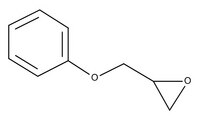820553 Sigma-AldrichEther époxy-2,3-propylphénylique
2,3-Epoxypropyl phenyl ether for synthesis. CAS 122-60-1, molar mass 150.17 g/mol.
More>> 2,3-Epoxypropyl phenyl ether for synthesis. CAS 122-60-1, molar mass 150.17 g/mol. Less<<Synonymes: Glycidyl phenyl ether, 1,2-Epoxy-3-phenoxypropane, Phenyl 2,3-epoxypropyl ether, Phenyl glycid ether
Produits recommandés
Aperçu
| Replacement Information |
|---|
Tableau de caractéristiques principal
| CAS # | Numéro CE | Formule de Hill | Masse molaire |
|---|---|---|---|
| 122-60-1 | 204-557-2 | C₉H₁₀O₂ | 150.18 g/mol |
Prix & Disponibilité
| Référence | Disponibilité | Conditionnement | Qté | Prix | Quantité | |
|---|---|---|---|---|---|---|
| 8205530250 |
|
Flacon en verre | 250 ml |
|
— |
| Description | |
|---|---|
| Référence | 820553 |
| Synonymes | Glycidyl phenyl ether, 1,2-Epoxy-3-phenoxypropane, Phenyl 2,3-epoxypropyl ether, Phenyl glycid ether |
| Références bibliographiques |
|---|
| Informations produit | |
|---|---|
| Numéro CAS | 122-60-1 |
| Numéro d'index CE | 603-067-00-X |
| Numéro CE | 204-557-2 |
| Formule de Hill | C₉H₁₀O₂ |
| Molar Mass | 150.18 g/mol |
| Code SH | 2910 90 90 |
| Image de la formule structurale | |
| Quality Level | MQ200 |
| Applications | |
|---|---|
| Application | 2,3-Epoxypropyl phenyl ether for synthesis. CAS 122-60-1, molar mass 150.17 g/mol. |
| Informations biologiques |
|---|
| Informations physico-chimiques | |
|---|---|
| Densité | 1.109 g/cm3 (20 °C) |
| Point d'éclair | 114 °C |
| Température d'inflammation | 430 °C |
| Point de fusion | 3.5 °C |
| Pression de vapeur | 0.013 hPa (20 °C) |
| Solubilité | 2.4 g/l |
| Dimensions |
|---|
| Informations sur les matériaux |
|---|
| Informations toxicologiques | |
|---|---|
| DL 50 orale | DL50 Rat 2150 mg/kg |
| DL 50 cutanée | DL50 Lapin 1500 mg/kg |
| Informations sur la sécurité | |
|---|---|
| Catégories de danger | cancérigène, nocif, irritant, mutagène, sensibilisant, dangereux pour l'environnement |
| Notifications sur l'utilisation du produit |
|---|
| Informations relatives au stockage et à l'expédition | |
|---|---|
| Stockage | Conserver au-dessous de +30°C. |
| Informations sur l'emballage |
|---|
| Informations sur le transport |
|---|
| Information complémentaire |
|---|
| Global Trade Item Number | |
|---|---|
| Référence | GTIN |
| 8205530250 | 04022536461267 |









